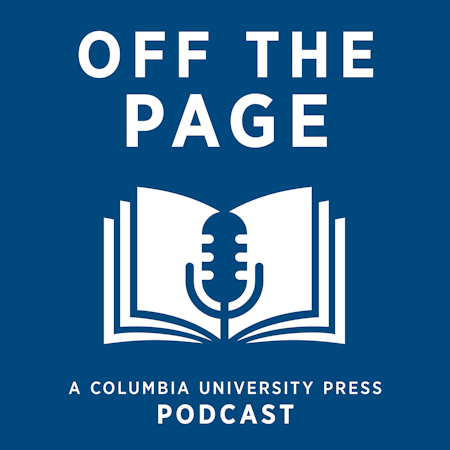
Off the Page: A Columbia University P...
Interviews with Columbia University Press authors.
351
Wendy Pearlman and Boaz Atzili, "Triadic Coerci...
In the post–Cold War era, states increasingly find themselves in conflicts with nonstate actors...
56 min
352
Jill Stauffer, "Ethical Loneliness: The Injusti...
Jill Stauffer argues that survivors of unjust treatment and dehumanization can experience further harm when individuals and institutions will not or cannot hear the survivors’ claims...
59 min
353
I. Gould Ellen and J. Steil, "The Dream Revisit...
Why do people live where they do? What explains the persistence of residential segregation?
56 min
354
Jamieson Webster, "Conversion Disorder: Listeni...
Entering into psychoanalysis takes courage, for patients and analysts alike...
41 min
355
Margaret Hennefeld, "Specters of Slapstick and ...
In the early days of film, female comedians appeared in films that included both strange activities and slapstick....
67 min
356
Alexandre Kojève, "Atheism," trans by Jeff Love...
Ranging across Heidegger, Buddhism, Christianity, German idealism, Russian literature, and mathematics, Kojève advances a novel argument about freedom and authority...
75 min
357
Thomas Patton, "The Buddha’s Wizards: Magic, Pr...
Thomas Patton examines the weizzā, a figure in Burmese Buddhism who is possessed with extraordinary supernatural powers, usually gained through some sort of esoteric practice...
67 min
358
Perrin Selcer, "The Postwar Origins of the Glob...
Having been born into a world in which people knew about anthropogenic global warming, I grew up in the “global environment.”
63 min
359
Howard Chiang, "After Eunuchs: Science, Medicin...
Howard Chiang’s new book is a masterful study of the relationship between sexual knowledge and Chinese modernity...
66 min
360
Arlene M. Sánchez Walsh, “Pentecostals in Ameri...
Arlene M. Sánchez Walsh‘s Pentecostals in America (Columbia University Press, 2018) offers a critical look at the history, key figures, and ideas that make Pentecostalism unique and challenges the narrative gloss offered by its adherents and church his...
60 min
361
Sandra Fahy, “Marching Through Suffering: Loss ...
Amidst an atmosphere of hope on the Korean Peninsula over the past year, questions over the wellbeing of North Korea’s population have again come to global attention. But this is far from the first time that such a subject has been in the news,
57 min
362
Adam Reich and Peter Bearman, “Working for Resp...
When we hear about the “future of work” today we tend to think about different forms of automation and artificial intelligence—technological innovations that will make some jobs easier and others obsolete while (hopefully) creating new ones we cannot y...
43 min
363
Austin Choi-Fitzpatrick, “What Slaveholders Thi...
According to the Walk Free Foundation, there are currently 46 million slaves in the world. Despite being against international law, slavery is not yet culturally condemned everywhere. Despite being human rights violators,
38 min
364
Jeffrey D. Sachs, "A New Foreign Policy: Beyond...
An interview with Jeffrey D. Sachs
56 min
365
Larry Shapiro, “The Miracle Myth: Why Belief in...
There are many who believe Moses parted the Red Sea and Jesus came back from the dead. Others are certain that exorcisms occur, ghosts haunt attics, and the blessed can cure the terminally ill. Though miracles are immensely improbable,
58 min
366
Philip Thai, “China’s War on Smuggling: Law, Ec...
From petty runs to organized trafficking, the illicit activity of smuggling on the China coast was inherently dramatic, but now historian Philip Thai has also identified China’s history of smuggling as a significant narrative about the expansion of sta...
66 min
367
Lily Wong, “Transpacific Attachments: Sex Work,...
Lily Wong‘s Transpacific Attachments: Sex Work, Media Networks, and Affective Histories of Chineseness (Columbia University Press, 2018) traces the genealogy of the Chinese sex worker as a figure who manifests throughout the 20th century in moments of ...
48 min
368
Paul Offit, “Bad Advice: Or Why Celebrities, Po...
You should never trust celebrities, politicians, or activists for health information. Why? Because they are not scientists! Scientists often cannot compete with celebrities when it comes to charm or evoking emotion.
49 min
369
Stephen Tankel, “With Us and Against Us: How Am...
With Us and Against Us: How America’s Partners Help and Hinder the War on Terror (Columbia University Press, 2018) offers readers a fresh, insightful and new perspective on US counterterrorism cooperation with complex countries like Saudi Arabia,
59 min
370
Michelle Pannor Silver, “Retirements and its Di...
How do different professionals experience retirement? Michelle Pannor Silver’s new book Retirements and its Discontents: Why We Won’t Stop Working, Even If We Can (Columbia University Press, 2018), explores this question and more through interview with...
61 min
371
Keith M. Woodhouse, “The Ecocentrists: A Histor...
Environmentalists often talk like revolutionaries but agitate like reformers. But however moderate its tactics, environmentalism has led Americans to questions rarely asked: Is economic growth necessary? Must individual freedom and democracy be paramou...
65 min
372
Sarah Snyder, “From Selma to Moscow: How Human ...
Human rights as a concern in U.S. foreign policy and international politics has been well-documented, particularly in studies of the Carter Administration. However, how human rights emerged as an issue in U.S.
55 min
373
Lauren-Brooke Eisen, “Inside Private Prisons: A...
Who benefits from mass incarceration in the U.S.? In her new book Inside Private Prisons: An American Dilemma in the Age of Mass Incarceration (Columbia University Press, 2017), Lauren-Brooke Eisen explain how,
28 min
374
Natalie Robins, “The Untold Journey: The Life o...
In her new book, The Untold Journey: The Life of Diana Trilling (Columbia University Press, 2017), Natalie Robins examines the life of writer and socialite Diana Trilling (1905-1996). Trilling wrote for The Nation, Harpers,
51 min
375
Holly Gayley, “Love Letters from Golok: A Tantr...
Often when people think of Tibetan Buddhism they have a limited vision of that social reality, perhaps one that imagines monks sitting in meditation or focused on the Dalai Lama. Rarely is the historical role of female Buddhist masters central to one’s...
53 min